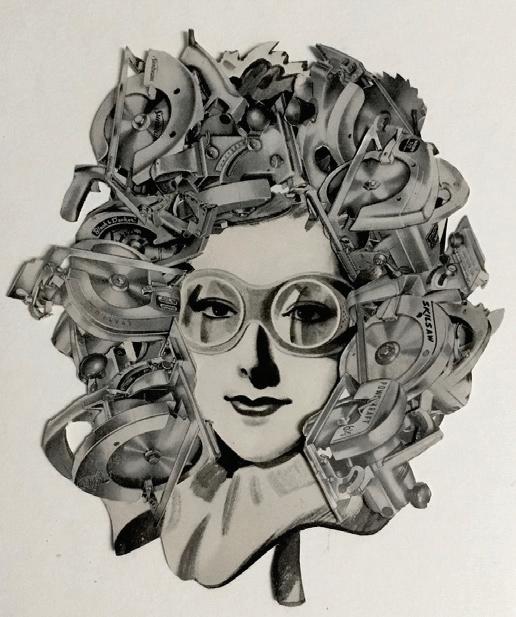
4 minute read
HEARTLAND HEALING
HEARTLAND HEALING Fool’s Gold
In the 1970s and ‘80s, eggs were getting a bad rap. Probably came from breakfast cereal companies of Battle Creek, Michigan. The fake news kept printing that eggs were bad. “Don’t eat eggs,” they said. “You’ll get cholesterol!” As if “cholesterol” was a disease or something.
About that time, I started going to the venerable Vince’s Gym in Studio City, California. I’ve written about Vince Gironda many times. Vince, a curmudgeonly Gypsy, was a hoofer, a bodybuilder, a movie actor and most famously a trainer to thousands of champion bodybuilders, Hollywood stars and celebrities.
“Vince’s” was historic; had its roots in the 1940s. A shotgun building on Ventura Boulevard, it is best described by the slogan printed on its plain, grey t-shirts: “No pool. No chrome. No music. Just iron.” There was no air conditioning, no fancy machines, no juice bar, not even windows. The handle on the heavy wood door was a 20-pound dumbbell. Walls were covered by full length mirrors, and you’d get tossed to the curb if you spent too much time chatting or standing about.
Vince and I somehow struck up a friendship, probably because he allowed me to bring him a double latte when I showed up to work out six days a week around 7 a.m. And in our conversations I learned that Vince knew more about nutrition, health, metaphysics and bodybuilding than Arnold and Jack LaLanne combined.
Raw truth. Vince took one look at scrawny me and said, “Fuzzy, I don’t want to take your money. You haven’t got a chance.” But the first thing he did was tell me what to eat. It included what Vince called “raw cream and raw scratch eggs” for breakfast. Raw meant cream from milk that came straight from the cow, never pasteurized nor homogenized. At the time, you could still buy raw cream in grocery stores in California. I doubt that is the case now. And “scratch eggs?” That meant true free-range eggs as we call them now. Vince meant eggs from hens that were allowed to roam the farm and “scratch” for worms and bugs.
When I started buying “scratch” eggs, I noticed something right away. The yolks had a deeper, yellower color. I learned it was mostly because of the carotene in a natural diet. A primary carotene source is grass. Believe it or not, chickens do eat grass. Now what that means to the consumer is that the egg is nutritionally balanced and the omega fatty acids work together to make it a nearly perfect food.
Carotene is a nutrient. When a free-range hen acquires it naturally, the deep color of the yolk suggests a healthful diet. But if the color is the result of an extract, it is little more than window dressing. So, in the summer I trust the yellow. In the winter I wonder if it’s just fool’s gold.
Faked out. Now, if you eat eggs from a trusted farmer who allows the chickens to run free on pasture, during the summer months you’ll find the yolks are very yellow. In winter, they are more pale because grass is scarce. Augmented grain with little carotene provides the bulk of a winter diet.
But heads up! I bought some “pastured eggs” the other day that demonstrate how easy it is to fool the consumer. I learned this a long time ago. Some farmers buy chicken feed that contains a coloring agent extracted from marigold flowers. You guessed it. There are times when that yellow color in the yolk is because the hen is eating an extract. It doesn’t mean anything other than cosmetics. It looks good to the consumer, but it does not mean that the chicken is getting the goods you might presume. It likely means the feed contains xanthophyll. Yummy.
From the Purina website, “For rich yellow yolks — A high level of xanthophyll, a coloring agent derived from marigolds, produces deep yellow egg yolks.”
In the winter, when grass and carotene are scarce, I am more likely to trust the farmer whose chickens lay eggs that are not so fake-yellow. If I’m seeing bright yellow egg yolks in February, I’ve pretty much concluded that farmer is selling fool’s gold.
Constructing favorable optics is commonplace with Big Food.
Bad air. Another optical illusion is in the meat industry. In today’s cancel culture, we don’t have to worry about Dr. Seuss’ Green Eggs and Ham any more. But then again, green meat was never all that appealing.
When you shop for steak at the supermarket, you won’t pick the steak with a tiny tinge of brown around the edges. And meat will start to turn after a time. Well, Big Food has an answer to that. Exposure to oxygen is the key. Keep oxygen away and the meat stays bright red for a longer period. The cello-wrapped steak is enclosed in what is called MAP or “modified atmosphere packaging.” The air in that pack could be carbon monoxide or another gas that scavenges oxygen molecules. No oxygen in the pack results in meat that stays red longer and has a longer optical shelf life. But that doesn’t mean it’s fresh. Red does not equal fresh just as rich does not equal smart.
My personal theory on MAP meat is that the product is resistant to oxygenation. Oxygen is needed for any fire. In a sense, digestion is nothing more than burning food. Oxygenation is part of digestion. If I eat a steak that has been treated to resist oxygenation, I’m eating a steak that will be more difficult to digest.
Don’t get fooled. Eat real food.
Be well.
BY Michael Braunstein
HEArtlAnd HEAlinG IS A METAPHYSICALLY BASED POLEMIC DESCRIBING ALTERNATIVES TO CONVENTIONAL METHODS OF HEALING THE BODY, MIND AND PLANET. IT IS PROVIDED AS INFORMATION AND ENTERTAINMENT, CERTAINLY NOT MEDICAL ADVICE. IMPORTANT TO REMEMBER AND PASS ON TO OTHERS: FOR A WEEKLY DOSE OF HEArtlAnd HEAlinG, VISIT HEARTLANDHEALING. COM.




